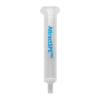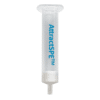PFCs
Perfluorinated compounds (PFCs)
Perfluorinated compounds (PFCs) are a large family of molecules consisting of varying lengths of fluorocarbons chains with a functional group such as carboxylic or sulfonic acids attached. They have been widely used for more than 50 years in various products, such as firefighting foams, hydrophobic and nonstick coatings, or surfactants to cite a few examples. Their nature makes them particularly chemically inert and very resistant to degradation in environment. They also tend to accumulate in living organisms. For this reason, some PFCs are classified as persistent organic pollutants (POPs).
Per- and polyfluoroalkyl substances (PFAS) have received worldwide attention in recent years. For example, the US EPA have has set an advisory limit of 70 ng/L in drinking water for PFOA and PFOS, and the EU Water Framework Directive added PFOA, its salts, and PFOA-related substances to the list of restricted substances in June 2017.
To detect trace concentrations of PFCs in water, it is highly recommended to use AttractSPE® WAX-PFC to concentrate samples prior to analysis.
AFFINISEP develops SPE columns compliant with EPA533 and EPA537 methods. EPA533 includes the analysis of multiple short-chain per- and polyfluoroalkyl substances (PFAS) that cannot be measured by Method 537 (citation of EPA533).
- POPs - PAHs - Perfluorinated compounds /
- PFCs
Analysis of 30 perfluorinated compounds (PFAS) in river water and tap water using AttractSPE®PFAS
NEW!
- POPs - PAHs - Perfluorinated compounds /
- PFCs

